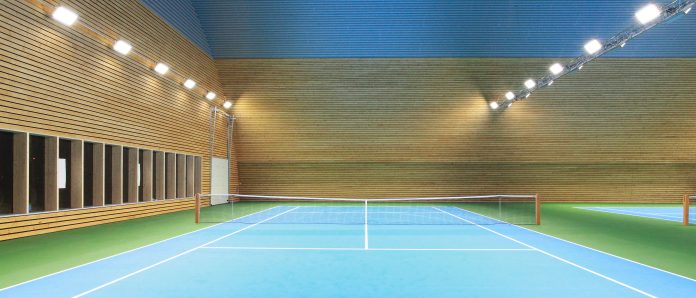Playing tennis demands an environment where precision, safety, and enjoyment seamlessly converge. Proper lighting on the tennis court is critical. It isn’t merely about visibility but creating the ideal setting for players to excel, regardless of the time of day. Here, we will navigate regulations and unveil the tapestry of key considerations.
The Regulatory Ballet of Tennis Court Lighting
1. Illumination Prowess
At the core of tennis court lighting regulations lies the formidable standard of light levels. The International Tennis Federation (ITF) leaves no room for ambiguity: the average horizontal illuminance on the court’s surface must embrace a robust 300 lux (lumens per square meter). This intensity is the sentinel, ensuring that players can precisely decipher the ball’s flight and respond with the swiftness it demands.
2. The Dance of Uniformity
Uniformity takes center stage to orchestrate a harmonious ballet of lighting. The ITF calls for a uniformity ratio of 1:3, decreeing that the minimum illuminance should constitute a third of the average. This equilibrium banishes the specter of glare and shadow, championing the cause of fair play and safety.
3. Taming the Glare Beast
To tame the glare beast and usher in crystal-clear visibility, tennis court lighting fixtures must be masters of subtlety. They must artfully direct their radiance downward, shielding players’ eyes from unwanted intrusion. A dance of fixture placement and design ensues, a choreography meticulously crafted to meet regulatory standards.
4. Flicker and Strobe
Flicker and strobe effects, those uninvited gatecrashers of the tennis court, must be vanquished. Their disorienting presence can be attributed to the power supply vagaries or the subpar lighting fixtures’ quality. The panacea lies in strict compliance with electrical standards, a shield against these unwanted disruptions to the performance.
5. Protecting the Nocturnal Symphony
In urban realms, the crescendo of light pollution threatens the nocturnal symphony. Regulations wield their might, commanding tennis court light to shield and confine its brilliance, preventing spillage beyond its boundaries. Thus, the night sky remains unperturbed, and neighbors enjoy peaceful repose, unburdened by intrusive radiance.
The Choreography of Key Considerations
1. Lighting Variations
In the tapestry of tennis court lighting, various lighting technologies take their positions: metal halide, LED, and high-pressure sodium. LED, the prima ballerina, garners accolades for its energy efficiency, enduring performance, and the ability to pirouette into instant illumination. Its finesse allows for meticulous control of lighting levels.
2. Illuminating Design
Proper lighting design becomes the choreographer, orchestrating the performance to meet the symphony’s requirements. Fixture count, placement, wattage, and beam angles dance in harmony. The maestro, a professional lighting designer, weaves the steps into an optimal layout, embracing regulatory standards and the court’s unique needs.
3. Maintenance
The encore beckons with a call for regular maintenance. Burnt-out bulbs and damaged fixtures must take their final bow promptly, ensuring the court remains bathed in the requisite luminance. This encore is vital to prevent the specter of glare from making an uninvited reappearance.
4. Energy Efficiency
The leap toward sustainability adds an elegant dimension. Energy-efficient lighting, led by the graceful LED, gracefully reduces operating costs while honoring the environment. It’s a choice that not only pleases the pocket but also bows to the planet’s needs.
5. Timing the Spotlight
As the final act, timer and control systems take the spotlight. They allow for a nuanced performance, adjusting lighting levels with the passage of day and the nuances of specific requirements. The encore is energy savings, and the finale is a regulation-compliant evening performance.
In conclusion, tennis court lighting is a sentinel, guarding player safety and elevating performance.











